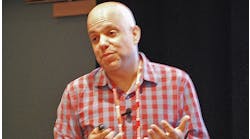“You can create or change applications with a style sheet, and it includes multi-language support.” Rockwell Automation’s Steve Briant gave ROKLive attendees a sneak preview of FactoryTalk Optix.
The FactoryTalk Hub suite will look different by the end of the year. FactoryTalk Optix, a new, scalable, cloud-enabled visualization platform with options, is expected to launch in November. ROKLive attendees got a sneak preview and demonstration of the upcoming addition to the FactoryTalk Hub suite in Orlando, Florida.
FactoryTalk Optix Studio is the integrated design environment for creating Optix projects. In it, users can design and test human-machine interface (HMI) projects directly from a web browser or desktop editor. The result of that design, a FactoryTalk Optix Application can be deployed to Rockwell Automation devices, third-party devices and PCs.
“We’re planning to launch this at Automation Fair,” said Steve Briant, visualization platform manager at Rockwell Automation, who explained the progress that’s been made so far on FactoryTalk Optix and predicted what path further development might take.
Users can design and test HMI projects directly from a web browser, explained Briant. Collaborative workflows allow modifications from anywhere. Version management tracks changes and identifies who made the changes. In addition, projects can be built dynamically by scripting or even at runtime.
Deployment options include flexible host hardware, open or closed deployment and a pay-for-what-you-use structure.
Responsive graphics are built in. “You can push to a widescreen format or narrow format,” explained Briant. “Built into the product is a reporting engine. You can create or change applications with a style sheet, and it includes multi-language support.”
Extensible options include a library tool that will allow for integration. “We have a suite of the most popular third-party automation drivers,” said Briant. “It has IoT native connectivity and full support of OPC/UA companion specs.”
Demonstrated Optix
Simone Mori, business development manager, Rockwell Automation, provided a demonstration of FactoryTalk Optix that showed key features in three phases—designing an application, collaborating with others and deployment to target devices.
Using the web-based FactoryTalk Optix Studio, Mori showed how to configure HMI graphics, data sources, including OPC/UA, and HMI alarming, trending and recipes.
Application design is broken down into using templates, linking them and then connecting automation. Templates are a collection of graphical objects combined with linkages for animations and user interactions. They can be assembled in any project or can be pulled from an existing library. Graphical containers can provide interfaces for opening, updating, logging and security. These interactions are enabled by linking the templates to the main page. Finally, connecting to automation can be done through tags or function calls using OPC/UA methods.
Multiple users can collaborate on the same FactoryTalk Optix application or using a GitHub repository. Mori demonstrated how changes are logged and versioned, as well as how conflicts are managed.
In the third phase, Mori showed how to deploy applications to different HMI devices, as well as make modifications to a running application after it’s already been deployed.
The editors of Control, Control Design and Smart Industry are reporting live from ROKLive 2022 in Orlando, Florida, to bring you the latest news and insights from the event. When the event comes to a close, the best, most important coverage will be compiled into a report by the editors.
Register now to pre-order the report and be among the first to receive it in your inbox.





